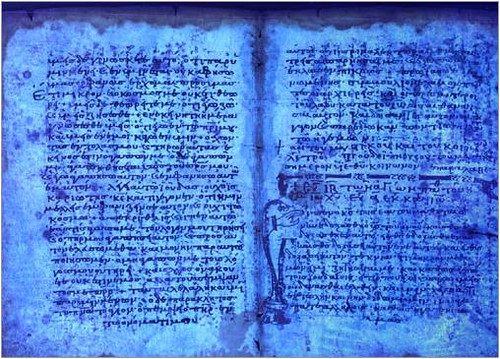
After centuries of mistreatment, the Archimedes palimpsest is in bad shape. During its thousand-year life, it has been scraped, singed by fire, dribbled with wax, smeared with glue, and ravaged by a deep purple fungus, which in places has eaten through its pages. Without the use of computer technology, the Archimedes palimpsest would be largely illegible. But modern imaging technologies, similar to those that helped experts read portions of the Dead Sea Scrolls in 1996, allow for astonishingly precise views of faded text.
Image source: Nova.
Has the ancient link between mathematics and prayer finally been discovered?
Researchers at Stanford University's Linear Accelerator Center in Menlo Park have been using x-rays to visualize hidden text of a 10th century manuscript that contains the only copies of some of Archimedes' most important mathematical thoughts and formulae. These x-rays are generated by a particle accelerator that cause iron deposits left by the original ink to glow without harming the fragile goatskin parchment on which it was printed.
Each page takes approximately 12 hours to scan using an x-ray beam, which is approximately the diameter of a human hair. Researchers expect to decipher up to 15 pages and, after each new page is visualized, it is published online for the public to see.
"We are focusing on the most difficult pages where the scholars haven't been able to read the texts," said Uwe Bergmann, the Stanford physicist heading the project.
The Archimedes palimpsest was the source for The Method, The Stomachion, and On Floating Bodies, all written in Greek. Unfortunately, it is known that at least three pages went missing after 1908 when John Ludwig Heiberg, the world's authority on Archimedes at the turn of last century, transcribed them, and even took a photograph of one page.
"We will never recover all of it," said William Noel, curator of manuscripts at Baltimore's Walters Art Museum, which organized the effort. "We are just getting as much as we can, and we are going to the ends of the earth to get it."
This manuscript was transcribed by an anonymous scribe(s) in the 10th century from the original papyrus scrolls written by Archimedes. These scrolls, which were lost, were based on the studies of a group of scholars, including Archimedes, who was an ancient mathematician, physicist and engineer who lived during the third century BC. This manuscript originally contained almost 90 pages before a Christian monk remade it into a prayer book containing 177 pages.
Palimpsests were common in antiquity because parchment was expensive and rare. A palimpsest (Greek; palimpsestos, or "scraped again") is a manuscript written on parchment that was originally part of another manuscript, resulting in two (or more) layers of visible writing. When a particular manuscript fell out of favor, it would be remade into a palimpsest by unbinding its parchment pages, which were scrubbed and refolded such that each page became two leaves in a new book that was half the size of the original manuscript.
In the early 1900s, the Archimedes palimpsest was believed stolen because it disappeared, but it was rediscovered in a manuscript collector's apartment in Paris in 1991, followed by a legal battle over the rightful ownership of the book. Finally, the Archimedes' palimpsest was purchased in 1998 by an American collector. This anonymous collector, a billionaire associated with Information Technology, paid $2 million for the manuscript at auction and loaned it to Walters Art Museum for conservation and study.
Since it was received, museum researchers have used a variety of methods to visualize the underlying hidden text, including ultraviolet and infrared filters, as well as digital cameras and processing techniques, but some pages remained unreadable because the document was badly damaged by mold.
X-rays created by synchrotron radiation will help to recover more of the ancient text without damaging the delicate parchment on which it was written. Synchrotron radiation is created when electrons traveling near the speed of light follow a curved path around a large ring. Bending the path of an electron causes it to emit light in a variety of wavelengths ranging from infrared to x-rays. These x-rays cause metals, such as the iron pigments contained in the palimpsest's ink, to glow. This fluorescence pattern is then "read" by a special detector that records and reassembles this information to create an image of the letters on the page.
"We are gaining new insights into one of the founding fathers of western science," said Noel. "[But] it is the most difficult imaging challenge on any medieval document because the book is in such terrible condition."
Sources:
AP (story, quotes)
A truly fascinating history of the Archimedes palimpsest.
Information and images about the history of the Archimedes palimpsest by Nova.
.
- Log in to post comments


That is very cool. Technology is really changing the world.
Deep Purple fungus? Is that Richie Blackmore's toupee?
Bob
Wow...that's beautiful. Very exciting!
Oh my god...the commenting actually worked! It's been months. I'm drunk with power now...
Nova has a good documentary titled: The Infinite Secrets of Archimedes that is about the palimsest as well. I saw it a few months back.
GOOD EXPLANATION GIVEN.
Thanks